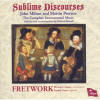Texte paru dans: / Appeared in:

Fanfare Magazine: 36:2 (11-12/2012)
Pour
s'abonner / Subscription information
Les abonnés à Fanfare Magazine ont accès aux archives du
magazine sur internet.
Subscribers to Fanfare Magazine have access to the archives of the magazine
on the net.
Regent Records
REGCD341

0802561034124 (IDV24)
Consultez toutes les évaluations recensées pour ce cd
~~~~ Reach all the evaluations located for this CD
Of the two composers featured here, Martin Peerson (c.1572–1651) was an extremely well-connected Catholic composer, yet highly regarded and rewarded by the Anglican Stuarts and their supporters. His consort music was probably intended as training for choirboys, for in contrast to the sacred works of his that survive, most are technically simple, with active, dance-like lines, repetitive voice-like motifs, simple counterpoint, and easily traceable structures. All of this serves to increase their resemblance to what we consider folk music—though it’s hardly surprising when classical, popular and folk, sacred and secular, were more flexible categories than they generally are today. This applies even more to his four surviving keyboard works, charming examples of the genre at its most direct.
The other composer on this release is John Milton (1562–1647). And no, not him. It’s his father, a scrivener by trade—which, given his considerable wealth, presumably meant the archaic “money scrivener,” the equivalent of a modern venture broker: one who receives monies to invest in enterprises that will bear the best interest. Our John came of a poor Catholic background, converted to Protestantism and moved to London, where he was successful enough to purchase the services of a private tutor for his son the future poet, and send him off to Christ’s College, Cambridge. He was also very fond of the arts, and music in particular. We have no surviving record of any training he received, but he did compose, mostly for domestic use, and presumably held music meetings at his home where his consort music could be played. The writing is more complex than Peerson’s but doesn’t usually approach Gibbons, Ward, or Byrd in its performance difficulty, and certainly not in its structural intricacy. Milton tends to prefer bouncing one or two short motifs into different keys, with accompaniments that are busily imitative rather than contrapuntally imaginative, and textures that are continuous rather than significantly varied. His In Nomine unusually states the text of the plainchant, and so it is performed here with countertenor Michael Chance in a setting that reveals more subtlety and interest than all but one of his other fantasias on this album.
This is the lightest fare I’ve yet heard on an entire CD from Fretwork. Peerson is responsible for the bulk of it, fortunately; 19 cuts, compared to Milton’s six. The slower tempos in their recording of Byrd’s consort music (Virgin Classics 45031) that led me to prefer Phantasm’s rhythmic snap and slightly faster pacing (Linn 372) are consequently less evident on this release, and the consort almost kicks up its heels in both Peerson’s “Beauty” Fantasia and a D-Minor Fantasia of his that concludes the program. The uniformly dark sound I’ve lauded elsewhere (Time Thy Musicke to They Hart, Fanfare 35:6) is certainly present, but Peerson’s fondness for spread, open textures also let plenty of sunlight in. They are joined by Sophie Yates, whose engaging, stylistically admirable playing is heard on her own personal instrument, a 2004 David Evans copy of an Italian-made virginal (c.1570) now in the Victoria & Albert Museum. Chance performs the plainchant in the In Nomine, where his timbre blends admirably with that of the gambists.
All in all,
this is a fun disc, and one that would provide new early-music listeners
with a fine introduction to consort music.
Fermer la fenêtre/Close window
Cliquez l'un ou l'autre
bouton pour découvrir bien d'autres critiques de CD
Click either button for many other reviews


